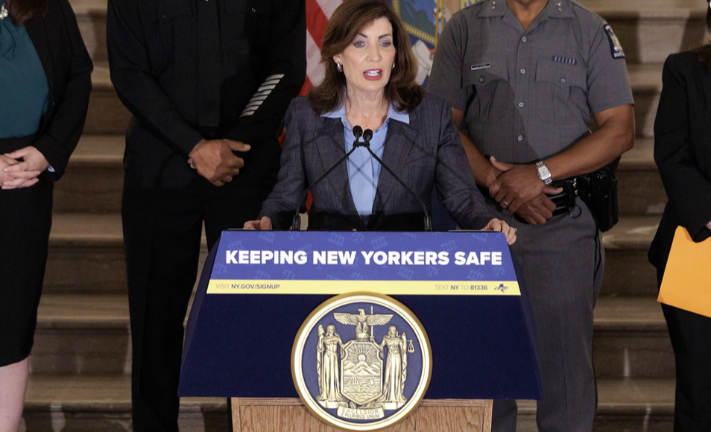NYS’s Nonpartisan Mapping Process Makes Fight Against Texas Tougher
Governor Kathy Hochul is on board to forgo the state’s established redistricting process, but the change won’t happen in time for the 2026 midterm elections.

New York has used an Independent Redistricting Commission (IRC) to draw congressional and legislative lines since 2014, when voters passed a constitutional amendment to ensure a fair redistricting process. The result was a committee whose members are neither legislators nor public officials, and it was established to avoid partisan gerrymandering.
But in a last-ditch effort to counter the aggressive GOP agenda, Governor Kathy Hochul, along with a handful of other Democratic governors, is willing to bend that precedent. But it won’t be easy and won’t be done in time for the next midterm election, in 2026.
Republicans in Texas are trying to force the issue in their state on a much more aggressive timeline. To try to thwart them, on Aug. 3 Texas Democratic lawmakers fled the state, hoping to block the passage of a mid-decade redistricting that would flip five Democratic seats during the 2026 midterm election. Their absence was meant to bypass the two-thirds majority required for a vote to be held. Now, the only thing standing between Texas and an even more Republican-leaning congressional map, is an unreached quorum.
That’s merely temporary, though, as the special session ends after 30 days and the missing lawmakers will have to return eventually. So Democrats, in Texas and nationally, are on the brink of resorting to Plan B. Or, more fittingly, Plan G, for gerrymandering.
On July 30, 2025, New York State Senator Michal Gianaris officially proposed an amendment to the state constitution. The move would preserve New York’s IRC process but give the state permission to forgo it if “another state does so more than once in a 10-year period.” Normally redistricting takes place after the decennial federal census.
In essence, the amendment allows the New York State Legislature to determine district lines if another state does so first. So if Texas gerrymanders, we can too.
“I’m tired of fighting this fight with my hands tied behind my back,” Governor Hochul said at a press conference in Albany. “With all due respect to the good-government groups, politics is a political process.”
But amending the state constitution isn’t easy, nor quick.
A constitutional amendment needs to pass the Legislature in Albany in two consecutive sessions, in this case 2025 and 2026. Even then, it still needs to be approved by a majority vote in a ballot measure in the subsequent year. If passed, it is ratified into the constitution the following January, which would be 2028.
“I wish I could just call a special election and change it. I’d do it in a heartbeat,” Governor Hochul told MSNBC. “I’m working hard with our legislative leaders to pass legislation . . . in this current session of the Legislature, go to the next one, which is required, so it won’t be until 2027 we can get it on the ballot. But what would that mean is, that in 2028 we could have different lines.”
California Governor Gavin Newsom has also proposed retaliation efforts, but like Governor Hochul, he governs a state that also has an Independent Redistricting Commission and therefore faces similar challenges. He has voiced asking California voters on the 2026 ballot if they approve of a state constitutional amendment. But that is still contingent on its passing the Legislature as well as a majority public vote.
Texas, on the other hand, never made the switch to an IRC process, and still uses its Legislature to determine district lines. The state doesn’t have to amend its constitution to call for a special session, as seen by their attempted mid-decade redistricting just last week. Right now, there are 219 Republicans and 212 Democrats, so if only four Republicans vote with the Democrats, it could hinder the agenda of President Trump.
Let’s say New York does amend the constitution for the 2028 election; it would happen well after the crucial 2026 midterm elections. And even if the Legislature were to propose a Democratic-leaning congressional map, who’s to say the appellate court won’t step in? After all, that’s what happened in 2022, when subtle gerrymandering occurred after the IRC couldn’t come to a consensus.
At the time, the 10-member bipartisan committee was split 5 to 5 on two rival maps. The solution was for the Democratic-dominant Legislature to draw up the map themselves, gerrymandering the districts to lean blue.
Even then, when the Legislature was merely used as a fallback, New York’s devotion to democracy prevailed, and the Court of Appeals struck down the Legislature’s map. A “special master” was appointed by the judge to determine district lines, and that map was used in the 2022 election. Gerrymandering was outlawed.
It’s worth noting that the 2014 amendment establishing the IRC was spearheaded by Governor Andrew Cuomo. In fact, ending “hyperpartisan” redistricting was one of his key campaign promises back in 2010. While the amendment was ultimately enacted, it took years and a few definitely partisan deals for it to be passed.
As Cuomo enters the last few months of his mayoral campaign and battles Democratic candidate Zohran Mamdani, he may just face some major redistricting déja vu. The midterm election is shaping up to be a high-stakes race, and the fight against Texas has only just begun.
A proposed amendment would allow the New York State Legislature to determine new district lines if another state does so first. So if Texas gerrymanders, we can too.